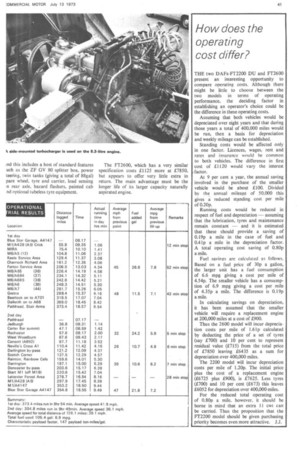How does the operating cost differ?
Page 43

If you've noticed an error in this article please click here to report it so we can fix it.
THE two DAFs-FT2200 DU and FT2600 present an interesting opportunity to compare operating costs. Although there might be little to choose between the two models in terms of operating performance, the deciding factor in establishing an operator's choice could be the difference in these operating costs.
Assuming that both vehicles would be depreciated over eight years and that during those years a total of 400,000 miles would be run, then a basis for depreciation and weekly mileage can be established.
Standing costs would be affected only in one factor. Licences, wages, rent and rates and insurance would he common to both vehicles. The difference in first cost of £1120 would vary the interest /factor.
At 9 per cent a year, the annual saving involved in the purchase of the smaller vehicle would be about £100. Divided by the annual mileage of 50.000 this gives a reduced standing cost per mile of 0.20p.
Running costs would be reduced in respect of fuel and depreciation assuming that the lubrication, tyres and maintenance remain constant and it is estimated that these should provide a saving of 0.19p a mile in the case of fuel and 0.41p a mile in the depreciation factor. A total operating cost saving of 0.80p a mile.
Fuel savings are calculated as follows. Based on a fuel price of 30p a gallon, the larger unit has a fuel consumption of 6.6 mpg giving a cost per mile of 4.54p. The smaller vehicle has a consumption of 6.9 mpg giving a cost per mile of 4.35p a mile. The difference is 0.19p a mile.
In calculating savings on depreciation, it has been assumed that the smaller vehicle will require a replacement engine at 200,000 miles at a cost of £900.
Thus the 2600 model will incur depreciation costs per mile of 1.61p calculated by deducting the price of a set of tyres (say £700) and 10 per cent to represent residual value (£715) from the total price of £7850 leaving £6435 as a sum for depreciation over 400,000 miles.
The 2200 model will incur depreciation costs per mile of 1.20p. The initial price plus the cost of a replacement engine (£6725 plus £900), is £7625. Less tyres (£700) and 10 per cent (£673) this leaves £6052 for depreciation over 400,000 miles.
For the reduced total operating cost of 0.80p a mile, however, it should be borne in mind that an extra 11 ewt can be carried. Thus the proposition that the FT2200 model should be given purchasing priority becomes even more attractive. J.J.
































































































